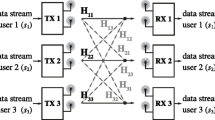Abstract
In order to accomplish practical deployment modelling for system performance evaluation and comparison for possible modulation and equalisation schemes to be used in HIPERLAN, a wide band tapped delay line (WTDL) channel model has been adopted by ETSI to characterise the multipath fading in the indoor radio environment. Based on this statistical channel model, and using Monte Carlo method, this paper evaluates the average probability of error for linear and decision feedback equaliser as a function of signal-to-noise ratio. It also evaluates the matched filter bound for this channel model. The results show the optimum performance levels achievable via the use of any equaliser.
Similar content being viewed by others
References
G.A. Halls, “HIPERLAN: The high performance radio local area network standard,” Electronics and Communication Engineering Journal/IEE, pp. 289–296, 1994.
“HIPERLAN; Functional specification,” January 1995. Draft, Version 1.1.
A. Nix et al., “Modulation and equalization considerations for high performance radio LANs (HIPERLAN),” in Wireless Computer Networks WCN'94, The Hague, pp. 964–968, 1994.
P.Balaban and J.Salz, “Dual diversity combining and equalization in digital cellular mobile radio,” IEEE Trans. Veh. Technol., vol. 40, pp. 342–354, 1991.
P.Balaban and J.Salz, “Optimum diversity combining and equalization in digital data transmission with applications to cellular mobile radio—Part I: Theoretical considerations,” IEEE Trans. Common., vol. 40, pp. 885–894, 1992.
S.W. Wales, “Receiver signal processing requirements of HIPERLAN modulation shemes,” RES10/TTG/93, 1993.
S.W. Wales, “Modulation and equalization techniques for HIPERLAN,” in Wireless Computer Networks WCN'94, The Hague, pp. 959–963, 1994.
“Hiperlan channel models and simulation results ETSI internal document number RES10/93/52, 1993.
G.A. Halls, “Modelling the HIPERLAN radio channel,” in Wireless Computer Networks WCN'94, The Hague, pp. 954–958, 1994.
G.A. Halls, “A software implementation of the HIPERLAN channel model,” RES10/TTG/93/46, 1993.
A.M.Saleh and R.A.Valenzula, “A statistical model for indoor multipath propagation,” IEEE J. Select. Areas. Commun., vol. SAC-5, pp. 128–137, 1987.
R.A.Valenzula, “Performance of adaptive equalization for indoor radio communications,” IEEE Trans. Commun., vol. 35, pp. 291–293, 1989.
R.A.Valenzula, “Performance of quadrature amplitude modulation for indoor radio communicaions,” IEEE Trans. Commun., vol. 35, pp. 1236–1238, 1987.
A. Nix et al., “Equalisation—a solution for HIPERLAN?,” ETSI Document RES 10/TTG/93/23, 1993.
P.Balaban and J.Salz, “Optimum diversity combining and equalization in digital data transmission with applications to cellular mobile radio— Part II: Numerical results,” IEEE Trans. Commun., vol. 40, pp. 895–907, 1992.
J.G.Proakis, Digital Communications, New York: McGraw Hill, 1989.
P.A.Bello, “Characterisation of randomly time-variant linear channels,” IEEE Trans. Commun., vol. 11, pp. 360–393, 1963.
J.E.Mazo, “Exact matched filter bound for two-beam Rayleigh fading,” IEEE Trans. Commun., vol. 39, pp. 1027–1030, 1991.
M.Schwartz, W.R.Bennett, and S.Stein, Communication Systems and Techniques. New York: McGraw-Hill, 1966.
P.Monsen, “Theoretical and measured performance of DFE modem on a fading multipath channel,” IEEE Trans. Commun. vol. 25, pp. 1144–1153, 1977.
Author information
Authors and Affiliations
Additional information
The work described in this paper was supported by the UK DTI/EPSRC LINK project: PC2011 “High Throughput Radio Modem” under EPSRC grant reference GR/K00318 in collaboration with Symbionics Networks limited.
Rights and permissions
About this article
Cite this article
Tellambura, C., Guo, Y.J. & Barton, S.K. Equaliser Performance for HIPERLAN in indoor channels. Wireless Pers Commun 3, 397–410 (1996). https://doi.org/10.1007/BF00461148
Issue Date:
DOI: https://doi.org/10.1007/BF00461148




